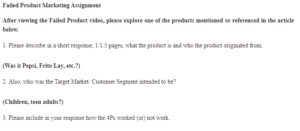Failed Product Marketing
Since the 1800s, cigarettes have become a popular commodity. The media has made it one of history’s most sought out items. However, controversy has arisen over the fact that smoking has adverse effects. Premier cigarettes created by R.J. Reynolds were intended to provide a product to “tobacco-addicted” consumers that would offer satisfaction without the adverse effects that regular cigarettes produced. According to a review written by NPC Incorporated, “it [was] clear from the chemical analysis of Premier’s mainstream particulate and vapor phase that Premier’s smoke [contained] far fewer chemical components at lower levels than the reference cigarettes…” (“NPC Incorporated”). It was even proven that it “produced no ashes, contained zero tar, and had 97% less nicotine and 70% less carbon monoxide than other brands” (Pollack).
Would you like an authentic copy of “Failed Product Marketing”? Get in touch with us.
However, the company’s credibility was questioned by companies such as Salomon Bros and other health advocates stating that the company “cannot make a health claim about ‘zero tar’,” nor is there such thing as a “safer cigarette” (Pollack). Premier cigarettes were marketed as a “safer” product, but many didn’t believe it. Even worse, consumers didn’t like the product. Mark Padgett, an employee at a 7- 11 store in Phoenix, stated, “They’re terrible. They’re nasty. They’re beyond nasty” (Wilson). Not only did their marketing strategy fail, they didn’t even produce a product that was consumer acceptable. Perhaps this would not have died if R.J. Reynolds had tested the product more, ensuring enough consumers were satisfied.
New Product development must be customer-centered, creating more customer-satisfying experiences and understanding consumers’ needs and values (Kotler, Armstrong). Premier missed an essential part of this process; creating a product that consumers like. This product failure teaches us to thoroughly understand what consumers want before producing a product we think will succeed in the market.
Similar Post: Trina Solar SWOT Analysis
References
Pollack, Judann. “Why the Curtain Should Not Have Fallen on RJR’s Premier.” Ad Age. (2012): n. page.
Web. 1 Apr. 2013. <http://adage.com/article/viewpoint/curtain-fallen-rjr-s- premier/231830/>.
“Re: R.J. Reynolds1 Premier Cigarette.” NPC Incorporated (1988): n.pag. Legacy Tobacco Documents Library. Web. 1 Apr 2013.
<http://legacy.library.ucsf.edu/tid/sut92i00/pdf;jsessionid=27920768C6C29DB3D23BA9 2F2503C8A2.tobacco03>.
Wilson, Susan. “R.J. REYNOLDS TOBACCO WITHDRAWS PREMIER CIGARETTE.” Ap News
Archive. (1989): n. page. Web. 1 Apr. 2013. <http://www.apnewsarchive.com/1989/R-J- Reynolds-Tobacco-Withdraws-Premier- Cigarette/id-eed3f7204b4f309ab4a438b1bec696e4>.
ORDER A PLAGIARISM-FREE PAPER HERE
We’ll write everything from scratch
Question 
Failed Product Marketing Assignment

Premier Cigarettes Product Failure
After viewing the Failed Product video, please explore one of the products mentioned or referenced in the article below.
- Please describe in a short response, 1/1.5 pages, what the product is and who the product originated from.
(Was it Pepsi, Frito Lay, etc.?)
- Also, who was the Target Market/ Customer Segment intended to be?
(Children, teen adults?)
- Please include in your response how the 4Ps worked (or) did not work.
Outside research should be (or can be) conducted for this assignment.
Use the article below for more examples to reference. https://www.cbinsights.com/research/corporate-innovation-product-fails/

